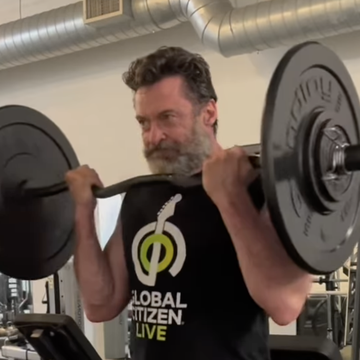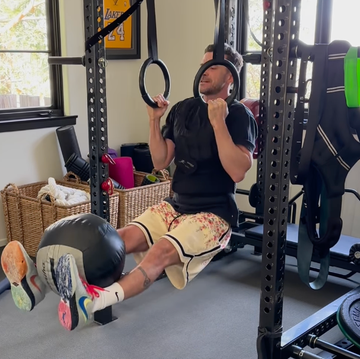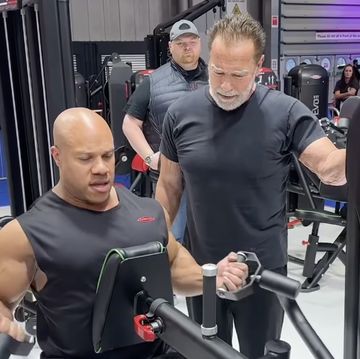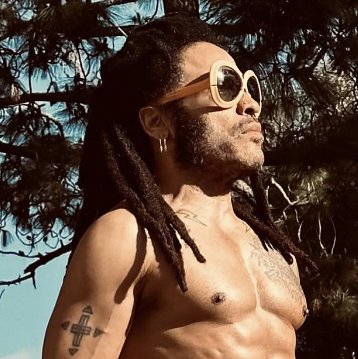Ten minutes. That's all the time country music star Kenny Chesney needs to pump out 300 pushups. It's a staggering number, especially when you consider it's more than most can do in an hour. (Just try it.)
But his secret is simple: vision and focus. In fact, it's this same clear vision and laser focus that took Chesney from singing for tips in Nashville bars back in the early 90s to landing his fourth consecutive Country Music Association Entertainer of the Year award last December. And all along, his fit, lean body has been a key part of his plan.
By 2001, Chesney had accumulated five number one singles. Only he longed not to be a country music star, but a country music brand. And that meant he needed to be the ultimate entertainer, in every aspect. That's when he hired personal trainer Daniel Meng, owner of MUV Fitness Coaching in Nashville, Tennessee. Meng's charge: to help the singer take his stage performance to an all-new level.
While Chesney was already in good shape, he needed to transform physically to put on what now would be the highest-energy concert in all of music. "I have to train to do my show the way I want to do it," he says. "I'm not one of these guys that just stands there behind the microphone. I work really hard to give the fans the best possible concert." The effort has paid off: Chesney has grossed approximately $500 million from concert ticket sales during the past 10 years.
What could a fitter, leaner, better-performing body do for you? Find out, by adopting the fitness and nutrition strategies that have arguably made Chesney the fittest man in country. (Or is it the fittest man in the country?)
Make Time to Sweat
Chesney's "Goin' Coastal" tour will take him all over North America this summer—from Philadelphia to Cuyahoga Falls to Indianapolis to Vancouver. But no matter how busy his schedule, Chesney never misses a workout—even if has to make it a quick one. "You'd be amazed at what you can do in a short amount of time to get a burn in, to feel healthier, to feel like you're not staying the same," he says.
So what if you just have 10 minutes? Try this pushup drill that Chesney uses when he doesn't have a minute to spare. "Start with 10 pushups, then rest 10 seconds," says Meng. "Then do 9 pushups, and rest 9 seconds; do 8 pushups, and rest 8 seconds, and so on, until you work your way down to 1 pushup." Warning: This isn't easy, so if needed, start with fewer pushups. Of course, as your fitness improves, you can also do more. "At one point, Kenny got to where he could start this drill at 24 pushups," says Meng. "Do the math: That's 300 pushups in 10 minutes."
Think Beyond the Gym
"I hate doing legs," says Chesney. "I've always hated it. I dread it. I'll walk into the gym knowing I've got to do them, and I try to get in the right frame of mind. But even after all these years of working out, I still hate it." Sound familiar? If so, remember this: Syracuse University researchers determined that people burned more calories the day after they did lower-body resistance training than the day after they worked their upper bodies. "Leg muscles—like your quads and glutes—generally have more muscle mass than those of your chest and arms," says study author Kyle Hackney, Ph.D. (c), C.S.C.S. "Work more muscle during your exercise session, and your body has to expend more energy to repair and upgrade them later."
If that's not motivation enough, ask yourself: Have you ever regretted a workout? Chances are, the answer is no. After all, when was the last time you heard someone complaining that they took the time to exercise? Which is why Chesney reminds himself to focus on how much he enjoys leaving the gym after he's finished a hard workout. "I love the way I feel when I'm done. I know I've accomplished something and I'm in a good mood the rest of the day because of it." And that's a notion that's supported by research, too. Georgia State University scientists found that it takes just 12 total sets of weight training—for example, 2 set of 6 exercises, or 3 sets of 4 exercises—to leave you feeling more energetic after a workout.
Take a Cheat Day
"I grew up with a family where everything revolved around food. I love to eat," he says. "But I'm very conscious of what I put in my body now." Each morning, the singer fuels up for the day with a nutrient-loaded breakfast of scrambled egg whites, grilled chicken, sliced tomatoes, and a whole-wheat bagel. And his favorite healthy snack? Grapes.
But perhaps the most important component of Chesney's diet is that he leaves room for a bit of indulgence. That's because he designates Sundays as his cheat day. "I eat whatever I want," he says. "If I want a chocolate-covered double cheeseburger, I'll eat it." The rationale is simple: If you know you always have one day to enjoy any kind of food you want, you'll be more likely to stick to a healthful diet the rest of the week.
Lose Yourself in Exercise
During a recent workout, Chesney hit the Green Bay Packers' gym at Lambeau Field. It's in this same stadium where he would perform in front of a crowd of more than 45,000 the following night. But this exercise session was less about his physical health, and more about his mental well-being. He needed to clear his head for a bit, forgetting for a moment about the tour, his friends who were stuck in a Chicago airport (on their way to his Wisconsin show), and the interviews he had scheduled for later that day. His get-away machine: the treadmill.
Only this isn't the typical read-a magazine-while-you-putter-along routine that you often see people perform in a health club. No, Chesney steps on the treadmill with purpose, pressing the up arrow on the incline control until the display reads "10." (Yes, 10.) Then he jumps on and sprints at a 9 mile-per-hour pace for 30 seconds, followed by 30 seconds of rest. Repeat that 9 more times, and you can replicate Chesney's stress-relieving workout. "When I'm at a 10 incline on the treadmill, I'm not thinking about everything else I have to do that day or what somebody wants or some place I have to be. There's not much you can think about when you're on a 10 incline," he says. That makes it surprisingly Zen, and a productive way to forget your troubles—even if it seems like the antithesis of a calming workout such as yoga or tai chi.
Dress the Part
"It's a demanding way of life, out here on the road," Chesney says of touring for the entire summer. "I just try to be mentally and physically in the best shape possible." In less than 48 hours, the country star will take the stage—for Lambeau Field's first-ever concert—dressed in his go-to performance uniform: a cowboy hat, boots, Levi's, and a sleeveless muscle shirt. Chesney works hard for those biceps, and you should, too. After all, your arms are the only major muscle group you can display almost anywhere, anytime. And if your arms are sculpted, people will assume the rest of your body is rock-solid as well. One technique that Chesney uses: A dumbbell curl with a static hold, says Meng.
It's simple: Grab a pair of dumbbells and let them hang at arm's length next to your sides, your palms facing forward. Without moving your upper arms, raise your forearm so your elbows are bent 90 degrees and hold them that way. This is the starting position. Now lower the dumbbell in your right hand until your arm is straight, then without moving your upper arm, curl the dumbbell toward your shoulder. Lower back to the starting position, then follow that same procedure with your left arm. That's one rep. Do a total of 10 repetitions. "If you really want to fry your biceps, continue to hold both dumbbells in the 90-degree position for an additional 10 seconds after your last rep," says Meng.
Kenny Chesney's On-the Road Workout
Country star Kenny Chesney hit it big with his chart-topping song “No Shirt, No Shoes, No Problem.” But what does one of the world’s fittest musicians do on tour when he finds himself with no gym? This body-weight routine, courtesy of the singer’s personal trainer, Daniel Meng. Try it yourself to blast fat and get fit.
Directions
Perform this body-weight circuit 3 days a week. Do 1 set of each exercise in succession, resting 30 seconds between exercises. After you’ve completed one circuit of all 10 exercises, rest for 2 minutes. Then repeat 2 to 3 more times.
1. Squat Thrust
Do 20 reps
Stand with your feet hip-width apart. Lower your body until your palms rest on the floor about shoulder-width apart. Kick your legs backward to a pushup position. Perform a pushup, and then quickly reverse the movement back to a squat. Immediately jumps as high as you can. Land softly, and repeat.
If that’s too hard: Simply rise to a standing position, instead of jumping up from the squat. You can also reduce the number of repetitions you perform.
2. Explosive Pushup
Do 15 reps
Assume a pushup position, your hands slightly beyond shoulder width. Your body should form a straight line from your ankles to your head. Bend your elbows and lower your body until your chest nearly touches the floor. Press yourself up with enough force that your hands leave the floor.
If that’s too hard: Do standard pushups. And if that’s still too hard, do pushups with your hands placed on an elevated surface, such as a bench.
3. Crouching Single-Leg Squat
Do 15 reps (each leg)
Stand with your feet hip-width apart and your knees slightly bent. Raise your left foot off the floor, and then bend your left knee 90 degrees, and hold it that way. Without rounding your lower back, push your hips back, bend your right knee, and lower your body until your left knee almost touches the floor. Reach forward as you perform the squat. Once at the bottom, push yourself back up to the starting position and repeat. Do all your reps, switch legs, and repeat.
If that's too hard: Simply lower your body as far as you can, then push back to the starting position.
4. Pullup
Do 10 to 15 reps
Grab a pullup bar with a shoulder-width overhand grip and hang at arm’s length. Pull your chest up to the bar. Lower back to the starting position and repeat.
5. Split Jump
Do 20 reps
Stand in a staggered stance with your feet 2 to 3 feet apart, your right foot in front of your left. Keeping your torso upright, bend your legs and lower your body into a lunge. Now jump with enough force to propel both feet off the floor. While you’re in the air, scissor-kick your legs so you land with your left leg forward. That's one rep. Repeat, alternating your forward leg for the duration of the set.
6. TRX Atomic Pushup
Do 15 reps
Attach TRX suspension training straps to a secure object. Then place your feet in the straps and assume a pushup position with your hands just wider than shoulder-width apart. Your body should form a straight line from your ankles to your head. Now do a pushup, by bending your elbows and lower your body until your chest nearly touches the floor. Press back up, and without rounding your lower back, pull your knees toward your chest. Reverse the movement back to the starting position. That’s one rep. (You can also perform this exercise with your feet on a Swiss ball, instead of strapped into the TRX.)
7. Single-Leg Hip Raise and Leg Curl
Do 15 reps (each leg)
Lie on your back with your left heel on a Swiss ball and hold your right leg in the air—so that it’s in line with your left thigh. Brace your core and hold it that way. Now squeeze your glutes and raise your hips off the floor until your body should forms a straight line from shoulders to knees. Then roll the ball toward your butt by bending your left knee and pulling the ball with your heel. Reverse the movement back to the starting position, and repeat.
If that’s too hard: Skip the single-leg version, and perform the exercise with both feet on the Swiss-ball.
8. TRX Inverted Row
Do 15 reps
Attach TRX suspension training straps to a secure object. Grab the handles of the TRX and hang with your arms completely straight. Your hands should be positioned directly above your shoulders and heels touching the floor. Your body should form a straight line from your ankles to your head. Squeeze your shoulder blades as you bend your elbows and pull the handles to the sides of your chest. Pause, then lower back to the starting position.
9. Plank Walkup to Pushup
Do 10 reps
Start to get into a pushup position, but bend your elbows and rest your weight on your forearms instead of your hands. Your body should form a straight line from your shoulders to your ankles. Now brace your core by contracting your abs as if you’re about to be punched in the gut. Without allowing your body posture to change, place your left hand on the floor, then your right hand. Then push your body into the “up” position of a pushup. Lower back down into a pushup. Then one at a time, place each elbow on the floor again. That’s one rep. Alternate which palm you place on the floor first.
10. Walking Plank
Move forward 75 to 150 feet
Chesney performs this exercise with his feet strapped into a power wheel, which allows him to roll backward and forward on grass, concrete, or any other surface. But if you don’t have a power wheel, you can do it on a tile or wood floor using a pair of hand towels. Assume a pushup position on a tile or hardwood floor and place each foot on a hand towel. Your body should form a straight line from your ankles to your head. Brace your abdominals—as if you were about to be punched in the gut—and maintain that contraction for the duration of this exercise. Now simply “walk” forward with your hands. letting your feet slide on the floor behind you as move. The key: Don’t allow your hips to sag at any time. Walk forward for about 25 yards, and then walk the same distance backward.
If that’s too hard: Shorten the distance you walk forward and back.












